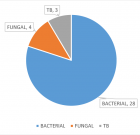Abstract
Research Article
Wound architectural analysis of 1.8mm microincision cataract surgery using spectral domain OCT
Benedito Antônio de Sousa, Anderson Teixeira*, Camila Salaroli, Nonato Souza and Lucy Gomes
Published: 12 August, 2019 | Volume 3 - Issue 2 | Pages: 008-012
Purpose: Analyze Microincision Cataract surgery wound using Fourier-Domain optical coherence tomography.
Setting: Medical School of Medicine, Catholic University of Brasilia, Brasília, Brazil.
Design: Prospective comparative observational study
Methods: Forty eyes were included in this prospective study divided in two groups: with contact lens (CL) and without contact lens (WCL). A line scan pattern of the corneal incisions were acquired using a Spectral domain OCT system immediately after the surgery, and at postoperative days 1, 7 and 30. Incisions were analyzed regarding length, location, angle, architecture, and anatomic imperfections.
Results: All incisions were located temporal or nasal superiorly. The average wound length was 1.28 + 0.18mm and the mean incision angle was 49 + 9 degrees. The average wound length of the WCL group mean was 1.24 + 0.17 mm and the mean incision angle was 51 + 8 degrees. Comparing groups for the length and the angle, the incisions measurements were not statistically significant. Anatomic imperfections were observed at the first day postoperative in 12 eyes for CL group and in 13 eyes for the WCL group. No patient presented endophthalmitis during the follow-up.
Conclusion: Epithelial imperfection was observed in two patients in the WCL group with spontaneous resolution. The CL group had the highest length and lowest angle of corneal incision. Using contact lens to prevent wound construction imperfection appears not to be a good option. Further studies using a greater number of patients with an architectural analysis of clear corneal incisions are needed to confirm these preliminary results.
Read Full Article HTML DOI: 10.29328/journal.ijceo.1001020 Cite this Article Read Full Article PDF
Keywords:
Cataract; Phacoemulsification; Spectral domain OCT; Self-sealing clear corneal incision; Microincision cataract system
References
- Lee KM, Kwon HG, Joo CK. Microcoaxial cataract surgery outcomes: comparison of 1.8 mm system and 2.2 mm system. J Cataract Refract Surg. 2009; 35: 874-880. PubMed: https://www.ncbi.nlm.nih.gov/pubmed/19393887
- Long DA, Monica ML. A prospective evaluation of corneal curvature changes with 3.0- to 3.5-mm corneal tunnel phacoemulsification. Ophthalmology. 1996; 103: 226-232. PubMed: https://www.ncbi.nlm.nih.gov/pubmed/8594506
- Weikert MP. Update on bimanual microincisional cataract surgery. Curr Opin Ophthalmol. 2006; 17: 62-67. PubMed: https://www.ncbi.nlm.nih.gov/pubmed/16436926
- Wilczynski M, Drobniewski I, Synder A, Omulecki W. Evaluation of early corneal endothelial cell loss in bimanual microincision cataract surgery (MICS) in comparison with standard phacoemulsification. Eur J Ophthalmol. 2006; 16: 798-803. PubMed: https://www.ncbi.nlm.nih.gov/pubmed/17191184
- Bourne RRA, Minassian DC, Dart JKG, Rosen P, Kaushal S, et al. Effect of cataract surgery on the corneal endothelium; modern phacoemulsification compared with extracapsular cataract surgery. Ophthalmology. 2004; 111: 679-685. PubMed: https://www.ncbi.nlm.nih.gov/pubmed/15051198
- Weikert MP, Wang L, Barrish J, Dimalanta R, Koch DD. Quantitative measurement of wound architecture in microincision cataract surgery. J Cataract Refract Surg. 2012; 38: 1460-1466. PubMed: https://www.ncbi.nlm.nih.gov/pubmed/22814053
- Schallhorn JM, Tang M, Li Y, Song JC, Huang D. Optical coherence tomography of clear corneal incisions for cataract surgery. J Cataract Refract Surg. 2008; 34: 1561-1565. PubMed: https://www.ncbi.nlm.nih.gov/pubmed/18721720
- Torres LF, Saez-Espinola F, Colina JM, Retchkiman M, Patel MR, et al. In vivo architectural analysis of 3.2 mm clear corneal incisions for phacoemulsification using optical coherence tomography. J Cataract Refract Surg. 2006; 32: 1820-1826. PubMed: https://www.ncbi.nlm.nih.gov/pubmed/17081864
- Calladine D, Packard R. Clear corneal incision architecture in the immediate postoperative period evaluated using optical coherence tomography. J Cataract Refract Surg. 2007; 33: 1429-1435. PubMed: https://www.ncbi.nlm.nih.gov/pubmed/17662437
- Can I, Bayhan HA, Celik H, Bostanci CB. Anterior segment optical coherence tomography evaluation and comparison of main clear corneal incisions in microcoaxial and biaxial cataract surgery. J Cataract Refract Surg. 2011; 37: 490-500. PubMed: https://www.ncbi.nlm.nih.gov/pubmed/21333873
- Lyles GW, Cohen KL, Lam D. OCT-documented incision features and natural history of clear corneal incisions used for bimanual microincision cataract surgery. Cornea. 2011; 30: 681-686. PubMed: https://www.ncbi.nlm.nih.gov/pubmed/21242779
- Fukuda S, Kawana K, Yasuno Y, Oshika T. Wound architecture of clear corneal incision with or without stromal hydration observed with 3-dimensional optical coherence tomography. Am J Ophthalmol. 2011; 151: 413-419e1. PubMed: https://www.ncbi.nlm.nih.gov/pubmed/21236408
- Xia Y, Liu X, Luo L, Zeng Y, Cai X, et al. Early changes in clear cornea incision after phacoemulsification: an anterior segment optical coherence tomography study. Acta Ophthalmol. 2009; 87: 764-768. PubMed: https://www.ncbi.nlm.nih.gov/pubmed/19548882
- Teixeira A, Salaroli C, Filho FR, Pinto FT, Souza N, et al. Architectural analysis of clear corneal incision techniques in cataract surgery using Fourier-domain OCT. Ophthalmic Surg Lasers Imaging. 2012; 43(Suppl): S103-108. PubMed: https://www.ncbi.nlm.nih.gov/pubmed/23357317
- Lee H, Kim EK, Kim HS, Kim TI. Fourier-domain optical coherence tomography evaluation of clear corneal incision structure according to blade material. J Cataract Refract Surg. 2014; 40: 1615-1624.
- Wylegala E, Teper S, Nowinska AK, Milka M, Dobrowolski DE. Anterior segment imaging: Fourier-domain optical coherence tomography versus time-domain optical coherence tomography. J Cataract Refract Surg. 2009; 35: 1410-1414. PubMed: https://www.ncbi.nlm.nih.gov/pubmed/19631129
- Can I, Bayhan HA, Celik H, Bostancı CB. Anterior segment optical coherence tomography evaluation and comparison of main clear corneal incisions in microcoaxial and biaxial cataract surgery. J Cataract Refract Surg. 2011; 37: 4 90-500. PubMed: https://www.ncbi.nlm.nih.gov/pubmed/21333873
- Mastropasqua L, Toto L, Vecchiarino L, Di Nicola M, Mastropasqua R. Microcoaxial torsional cataract surgery 1.8 mm versus 2.2 mm: functional and morphological assessment. Ophthalmic Surg Lasers Imaging. 2011; 42:114-124. PubMed: https://www.ncbi.nlm.nih.gov/pubmed/21323269
- Mahdy MA, Eid MZ, Mohammed MA, Hafez A, Bhatia J. Relationship between endothelial cell loss and microcoaxial phacoemulsification parameters in noncomplicated cataract surgery. Clin Ophthalmol. 2012; 6: 503-510. PubMed: https://www.ncbi.nlm.nih.gov/pubmed/22536044
- Park JH, Lee SM, Kwon J-W, Kim MK, Hyon JY, et al. Ultrasound energy in phacoemulsification: a comparative analysis of phaco-chop and stop-and-chop techniques according to the degree of nuclear density. Ophthalmic Surg Lasers Imaging. 2010; 41: 236-241. PubMed: https://www.ncbi.nlm.nih.gov/pubmed/20307043
- Marshall J, Trokel S, Rothery S, Krueger RR. A comparative study of corneal incisions induced by diamond and steel knives and two ultraviolet radiations from an excimer laser. Br J Ophthalmol. 1986; 70: 482–501. PubMed: https://www.ncbi.nlm.nih.gov/pubmed/3013283
- Taban M, Rao B, Reznik J, Zhang J, Chen Z, et al. Dynamic morphology of sutureless cataract wounds--effect of incision angle and location. Surv Ophthalmol. 2004; 49 (Suppl 2): S62-72. PubMed: https://www.ncbi.nlm.nih.gov/pubmed/15028481
- Huang D, Swanson EA, Lin CP, Schuman JS, Stinson WG, et al. Optical coherence tomography. Science. 1991; 254: 1178-1181. PubMed: https://www.ncbi.nlm.nih.gov/pubmed/1957169
- McDonnell PJ, Taban M, Sarayba M, Rao B, Zhang J, et al. Dynamic morphology of clear corneal cataract incisions. Ophthalmology. 2003; 110: 2342-2348. PubMed: https://www.ncbi.nlm.nih.gov/pubmed/14644716
- Fine IH, Hoffman RS, Packer M. Profile of clear corneal cataract incisions demonstrated by ocular coherence tomography. J Cataract Refract Surg. 2007; 33: 94-97. PubMed: https://www.ncbi.nlm.nih.gov/pubmed/17189800
- Fukuda S, Kawana K, Yasuno Y, Oshika T. Repeatability and reproducibility of anterior chamber volume measurements using 3-dimensional corneal and anterior segment optical coherence tomography. J Cataract Refract Surg. 2011; 37: 461-468. PubMed: https://www.ncbi.nlm.nih.gov/pubmed/21333870
Figures:

Figure 1

Figure 2
Similar Articles
-
A Comparative Study of Anatomic and Functional Outcomes of Two Surgical Techniques of Cataract at LomeAyena KD*,Santos KAM,Vonor K,Amedome KM,Wodome A,Strauss G,Nagbe YE,Koffi-Ametooyona A, Balo K. A Comparative Study of Anatomic and Functional Outcomes of Two Surgical Techniques of Cataract at Lome . . 2017 doi: 10.29328/journal.hceo.1001001; 1: 001-008
-
The management of Irvine-Gass Syndrome in a patient using Inhaler SteroidAyse Gul Kocak Altintas*,Cagri Ilhan,Mehmet Citirik. The management of Irvine-Gass Syndrome in a patient using Inhaler Steroid . . 2018 doi: 10.29328/journal.ijceo.1001011; 2: 001-005
-
Place of beta-radiation in the etiology and treatment of cataractYasemin Benderli Cihan*. Place of beta-radiation in the etiology and treatment of cataract . . 2018 doi: 10.29328/journal.ijceo.1001012; 2: 006-007
-
Ocular changes and disorders associated with ObesityBurak Turgut*. Ocular changes and disorders associated with Obesity. . 2018 doi: 10.29328/journal.ijceo.1001015; 2: 018-020
-
Alternative treatment methods in eyes with pseudophakic cystoid macular edemaAyse Gul Kocak Altintas*. Alternative treatment methods in eyes with pseudophakic cystoid macular edema . . 2019 doi: 10.29328/journal.ijceo.1001019; 3: 001-007
-
Wound architectural analysis of 1.8mm microincision cataract surgery using spectral domain OCTBenedito Antônio de Sousa, Anderson Teixeira*,Camila Salaroli,Nonato Souza,Lucy Gomes. Wound architectural analysis of 1.8mm microincision cataract surgery using spectral domain OCT. . 2019 doi: 10.29328/journal.ijceo.1001020; 3: 008-012
-
Two different patterns and outcome of neodymium YAG capsulotomySudeep Navule Siddappa*, Darshan Shivaura Mahalingu, Rakesha Anjenappa,Tintu Susan Joy. Two different patterns and outcome of neodymium YAG capsulotomy. . 2020 doi: 10.29328/journal.ijceo.1001027; 4: 012-014
-
Changes in intraocular pressure after ND-yag laser posterior capsulotomyHashim Thiab Hassan*. Changes in intraocular pressure after ND-yag laser posterior capsulotomy. . 2020 doi: 10.29328/journal.ijceo.1001029; 4: 021-030
-
Pattern of ocular diseases among patients attending ophthalmic outpatient department: A cross-sectional studySewunet Ademe*, Afework Edmealem. Pattern of ocular diseases among patients attending ophthalmic outpatient department: A cross-sectional study. . 2020 doi: 10.29328/journal.ijceo.1001033; 4: 049-053
-
A comparative study of post-operative astigmatism in superior versus superotemporal scleral incisions in manual small incision cataract surgery in a tertiary care hospitalSoumyadeep Hazra*,Tapes Kanti Saha. A comparative study of post-operative astigmatism in superior versus superotemporal scleral incisions in manual small incision cataract surgery in a tertiary care hospital. . 2021 doi: 10.29328/journal.ijceo.1001036; 5: 009-015
Recently Viewed
-
Enlarged Curvature, Torsion and Torque in Helical Conformations and the Stability and Growth of α-Peptide under the Isochoric and Isobaric Conditions: Variatonal OptimizationTarik Omer Ogurtani*. Enlarged Curvature, Torsion and Torque in Helical Conformations and the Stability and Growth of α-Peptide under the Isochoric and Isobaric Conditions: Variatonal Optimization. Ann Biomed Sci Eng. 2024: doi: 10.29328/journal.abse.1001032; 8: 039-058
-
Satellite-Based Analysis of Air Pollution Trends in Khartoum before and After the ConflictHossam Aldeen Anwer*,Abubakr Hassan,Ghofran Anwer. Satellite-Based Analysis of Air Pollution Trends in Khartoum before and After the Conflict. Ann Civil Environ Eng. 2025: doi: 10.29328/journal.acee.1001074; 9: 001-011
-
Chemical constituents and biological activities of Artocarpus heterophyllus lam (Jackfruit): A reviewSibi G*,Pranay Raja Bhad,Meeneri Vilas Bobde. Chemical constituents and biological activities of Artocarpus heterophyllus lam (Jackfruit): A review. Int J Clin Microbiol Biochem Technol. 2021: doi: 10.29328/journal.ijcmbt.1001019; 4: 005-009
-
Challenges in Y-DNA Recovery from Fabric: Effects of Environmental Degradation and Implications for Forensic CaseworkNaina Sharma,Surya Shekhar Daga*. Challenges in Y-DNA Recovery from Fabric: Effects of Environmental Degradation and Implications for Forensic Casework. J Forensic Sci Res. 2025: doi: 10.29328/journal.jfsr.1001090; 9: 117-124
-
Expression of Collagen VI, Anticollagenase, Laminin, MM9, Claudins 1 and 5, N and E Cadherins in Choroid Plexus TumorsMartha Lilia Tena-Suck, Laura Chavez Macias, Erick Gómez-Apo, Alma Ortiz Plata, Carmen Rubio*. Expression of Collagen VI, Anticollagenase, Laminin, MM9, Claudins 1 and 5, N and E Cadherins in Choroid Plexus Tumors. Arch Pathol Clin Res. 2023: doi: 10.29328/journal.apcr.1001037; 7: 020-027
Most Viewed
-
Feasibility study of magnetic sensing for detecting single-neuron action potentialsDenis Tonini,Kai Wu,Renata Saha,Jian-Ping Wang*. Feasibility study of magnetic sensing for detecting single-neuron action potentials. Ann Biomed Sci Eng. 2022 doi: 10.29328/journal.abse.1001018; 6: 019-029
-
Evaluation of In vitro and Ex vivo Models for Studying the Effectiveness of Vaginal Drug Systems in Controlling Microbe Infections: A Systematic ReviewMohammad Hossein Karami*, Majid Abdouss*, Mandana Karami. Evaluation of In vitro and Ex vivo Models for Studying the Effectiveness of Vaginal Drug Systems in Controlling Microbe Infections: A Systematic Review. Clin J Obstet Gynecol. 2023 doi: 10.29328/journal.cjog.1001151; 6: 201-215
-
Prospective Coronavirus Liver Effects: Available KnowledgeAvishek Mandal*. Prospective Coronavirus Liver Effects: Available Knowledge. Ann Clin Gastroenterol Hepatol. 2023 doi: 10.29328/journal.acgh.1001039; 7: 001-010
-
Causal Link between Human Blood Metabolites and Asthma: An Investigation Using Mendelian RandomizationYong-Qing Zhu, Xiao-Yan Meng, Jing-Hua Yang*. Causal Link between Human Blood Metabolites and Asthma: An Investigation Using Mendelian Randomization. Arch Asthma Allergy Immunol. 2023 doi: 10.29328/journal.aaai.1001032; 7: 012-022
-
An algorithm to safely manage oral food challenge in an office-based setting for children with multiple food allergiesNathalie Cottel,Aïcha Dieme,Véronique Orcel,Yannick Chantran,Mélisande Bourgoin-Heck,Jocelyne Just. An algorithm to safely manage oral food challenge in an office-based setting for children with multiple food allergies. Arch Asthma Allergy Immunol. 2021 doi: 10.29328/journal.aaai.1001027; 5: 030-037

HSPI: We're glad you're here. Please click "create a new Query" if you are a new visitor to our website and need further information from us.
If you are already a member of our network and need to keep track of any developments regarding a question you have already submitted, click "take me to my Query."















































































































































